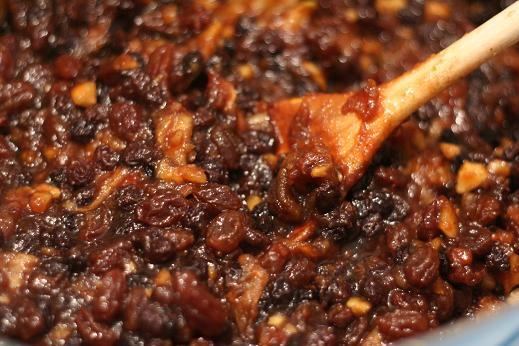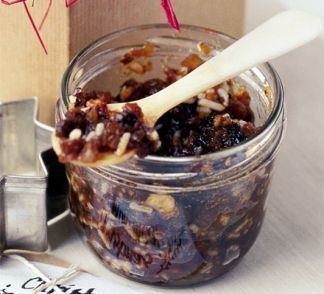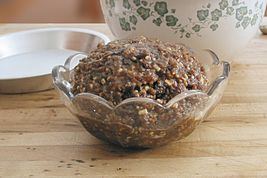 | ||
Similar | ||
How to make mincemeat recipe video
Mincemeat is a mixture of chopped dried fruit, distilled spirits and spices, and sometimes beef suet, beef, or venison. Originally, mincemeat always contained meat. Many modern recipes contain beef suet, though vegetable shortening is sometimes used in its place. Variants of mincemeat are found in Australia, Canada, New Zealand, northern Europe, Ireland, South Africa, the United Kingdom and the United States. In other contexts mincemeat refers to minced or ground meat.
Contents
- How to make mincemeat recipe video
- Homemade mincemeat recipe demonstration joyofbaking com
- Variants and history
- A 16th century recipe
- A 19th century recipe
- 20th century
- Etymology
- References

Homemade mincemeat recipe demonstration joyofbaking com
Variants and history

English recipes from the 15th, 16th, and 17th centuries describe a mixture of meat and fruit used as a pie filling. These early recipes included vinegars and wines, but by the 18th century, distilled spirits, frequently brandy, were being used instead. The use of spices like clove, nutmeg, mace and cinnamon was common in late medieval and renaissance meat dishes. The increase of sweetness from added sugars, and those produced from fermentation, made mincemeat less a savoury dinner course and helped to direct its use toward desserts.
A 16th-century recipe

Pyes of mutton or beif must be fyne mynced & seasoned with pepper and salte and a lytel saffron to colour it / suet or marrow a good quantitie / a lytell vynegre / pruynes / great reasons / and dates / take the fattest of the broath of powdred beefe. And if you will have paest royall / take butter and yolkes of egges & so to temper the floure to make the paest.

(Pie filling of mutton or beef must be finely minced and seasoned with pepper and salt and a little saffron to colour it. [Add] a good quantity of suet or marrow, a little vinegar, prunes, raisins and dates. [Put in] the fattest of the broth of salted beef. And, if you want Royal pastry, take butter and egg yolks and [combine them with] flour to make the paste.)
In the mid to late eighteenth century, mincemeat in Europe had become associated with old fashioned, rural, or homely foods. Victorian England rehabilitated the preparation as a traditional Yuletide treat.
A 19th-century recipe
20th century
By the mid-twentieth century the term was also used to describe a similar mixture that does not include meat, but that might include animal fat in the form of suet or butter, but could also substitute solid vegetable fats, making it vegetarian. Many recipes continue to include suet, venison, minced beef sirloin or minced heart, along with dried fruit, spices, chopped apple, and fresh citrus peel, Zante currants, candied fruits, citron, and brandy, rum, or other liquor. Mincemeat is aged to deepen flavours, activate the preserving effect of alcohol, which over time changes the overall texture of the mixture by breaking down the meat proteins. Preserved mincemeat may be stored for up to ten years.
Mincemeat can be produced at home, often using a family recipe that varies by region or ancestry. Commercial preparations, primarily without meat, packaged in jars, foil lined boxes, or tins are commonly available.
Mincemeat is frequently consumed during the Christmas holiday season when mince pies or mincemeat tarts are served. In the northeast United States, mincemeat pies are also a traditional part of the Thanksgiving holiday, sometimes served with a piece of Cheddar cheese.
Etymology
The "mince" in mincemeat comes from the Middle English mincen, and the Old French mincier both traceable to the Vulgar Latin minutiare and Latin minutia meaning smallness. The word mincemeat is an adaptation of an earlier term minced meat, meaning finely chopped meat. Meat was also a term for food in general, not only animal flesh.
"Making mincemeat of" somebody means defeating them easily and soundly at something.
